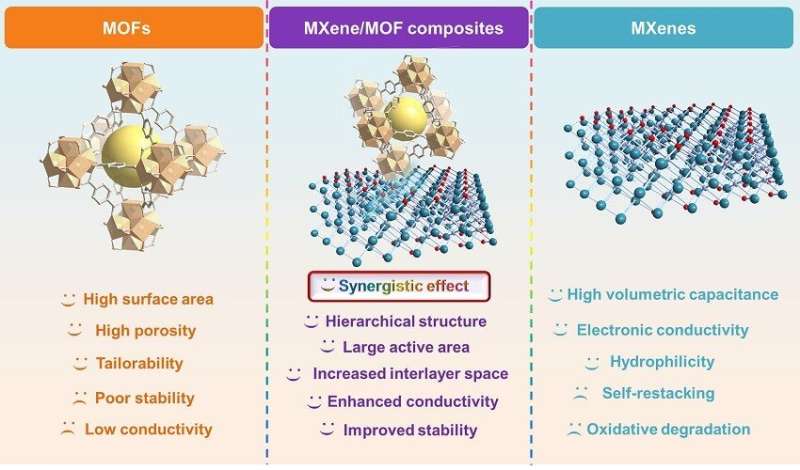This article has been reviewed according to Science X's editorial process and policies. Editors have highlighted the following attributes while ensuring the content's credibility:
fact-checked
proofread
Metal−organic frameworks meet MXene: New opportunities for electrochemical application

New work on MXene/MOF hybrid materials has been published in Energy Material Advances.
"The investigation of MXene/MOF hybrid materials with high electrochemical performance is important," said paper author Huan Pang, professor with the School of Chemistry and Chemical Engineering, Yangzhou University. "Currently, MXene/MOF hybrid materials have received increasing attention in energy-related fields."
Pang explained the motivations for designing MXene/MOF hybrid materials.
Firstly, MXenes with numerous negatively charged surface groups can be employed as a valid substrate to support the growth of MOFs, thus not only preventing the aggregation of MOF nanoparticles and MXene nanosheets, but also exposing more available surface areas.
Secondly, the highly conductive MXene framework in the hybrids can provide sufficient conductive channels and shortened ion-diffusion pathway. Thirdly, the strong interfacial interactions between MXene and MOFs offer superior structural integrity and stability.
Finally, the tunable crystal structure and diverse morphologies of MOFs can help the hybrids accommodate various specific applications. Therefore, it is promising to employ MXene/MOF composites as functional materials for high-performance electrochemical devices.
"In this review, we systematically discussed and summarized the synthesis strategies of MXene/MOF composites as well as the derivation process of MXene/MOF-derived materials. Then, the important electrochemical applications of MXene/MOF composites and their derivatives, which covered supercapacitors, alkali metal-ion batteries, multivalent ion batteries, LSBs, water splitting, and ORR, were comprehensively analyzed and concluded," Pang said.
"The introduction of MXene can effectively compensate for the chemical instability and low electron conductivity of MOFs. In turn, the severe oxidation degradation and self-stacking of MXene can be well resolved by the implant of MOFs."
"Numerous works have demonstrated that MXene/MOF composites exhibit better electrochemical properties (such as specific capacities, rate performance, cycling stability, Tafel slope, etc.) than that of pure MXene and pristine MOFs because of the well-designed structure, strong interfacial interaction, sufficient active sites, and exoteric conductive channels. Moreover, various functional MOF-derived nanomaterials have been successfully coupled with MXene and delivered greatly enhanced electrochemical performance."
"Despite many significant achievements in MXene/MOF composites and their derivatives have been published, their application in the electrochemistry field was still in its infancy," Pang said. "For better development in the future, the major challenges and perspectives of MXene/MOF composites and their derivatives were discussed."
"The following aspects are noteworthy," Pang said. "First, improve the diversity of MXene/MOF composites; second, optimize synthetic strategies; third, construct interfacial interactions; fourth, design complex architectures; fifth, explore MXene-derived MOF; sixth, fabricate energy-involved devices; finally, understand working mechanisms."
"Although MXene/MOF composites and their derivatives face many challenges yet to be addressed, the significant progress that they have made in electrochemical energy storage and conversion was witnessed by us all," Pang said. "We believed that the review will contribute to a deeper understanding of functional MXene/MOF-based composites, and provide valid guidance for their future development in the field of electrochemical applications."
More information: Hui Yang et al, Metal–Organic Frameworks Meet MXene: New Opportunities for Electrochemical Application, Energy Material Advances (2023). DOI: 10.34133/energymatadv.0033
Provided by Beijing Institute of Technology Press Co.




















